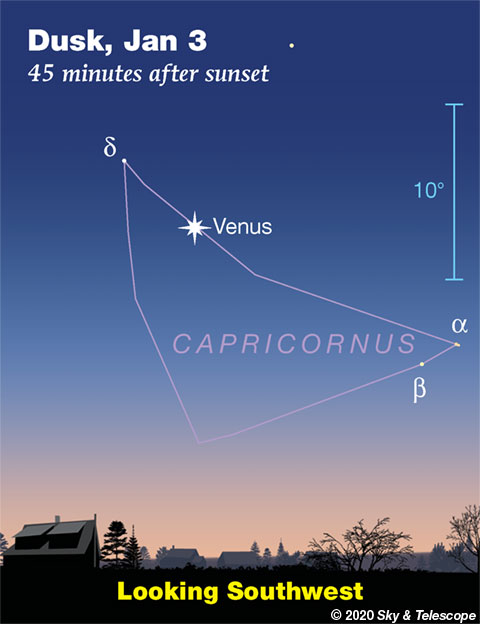
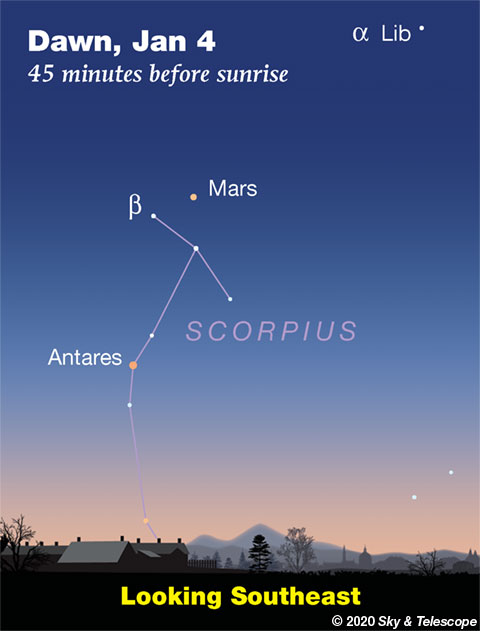
Friday, Jan. 3
• This year the brief Quadrantid meteor shower is — at last! — well timed for North America, especially the East. Tonight Earth is predicted to pass through the densest part of the Quadrantid meteoroid stream for roughly six hours centered around 3 a.m. Saturday morning January 4th Eastern Standard Time, right in the favorable early-morning meteor-watching hours for the East. Wherever you are, the first-quarter Moon sets around 1 or 2 a.m. local time. Under ideal dark conditions with the radiant overhead you might see up to 120 meteors per hour. Off peak, your count may be more like a dozen or two per hour at best.
Bundle up warmly in many layers! This is the coldest time of night at the coldest time of year, and if the sky is clear, which it will be if you're meteor-watching, you're exposed to radiational cooling to boot. And you'll be sitting or lying still as you gaze into the stars overhead. But as every astronomer knows, there is no too cold, there is only underdressed. I sometimes bundle a 50-watt hotpad inside my clothes, connected to the house by a long extension cord. Put it against your belly, and blood circulation will carry some of the warmth to your toes and fingertips.
The shower's radiant is in northern Bootes. For more see Bob King's High Hopes for the 2020 Quadrantid Meteor Shower.
Saturday, Jan. 4
• After dark, look above the waxing gibbous Moon for the two, or possibly three, brightest stars of Aries: Hamal, Sheratan, and fainter Mesarthim.
• Earth is at perihelion, its closest to the Sun for the year, at 2:48 a.m. on the morning of January 5th EST. This week we're 3.3 percent closer to the Sun than at aphelion in July.
• Purely by coincidence, January 5th also has the latest sunrise of the year if you're near 40° north latitude.
Sunday, Jan. 5
• In this very coldest time of the year, the dim Little Dipper (Ursa Minor) hangs straight down from Polaris after dinnertime, as if (per Leslie Peltier) from a nail on the cold north wall of the sky.
The Big Dipper, meanwhile, is creeping up low in the north-northeast. Its handle is very low and its bowl is to the upper right.
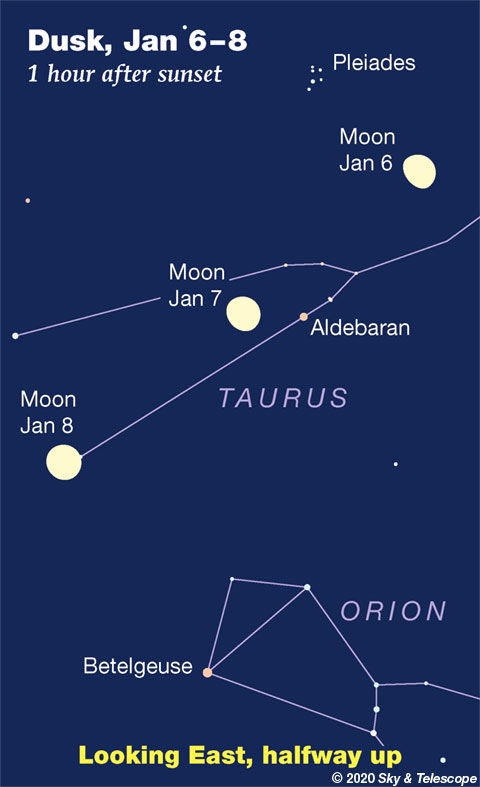
Monday, Jan. 6
• Sirius now rises around 7 p.m., depending on where you live. Orion's three-star Belt points down almost to its rising place; watch there. Once Sirius is up, it twinkles slowly and deeply through the thick layers of low atmosphere, then faster and more shallowly as it gains altitude. Its flashes of color also diminish and blend into shimmering whiteness as it climbs to shine through thinner air.
Tuesday, Jan. 7
• The waxing gibbous Moon shines in Taurus, just a few degrees left of orange Aldebaran in early evening. Spot the Pleiades farther to the Moon's upper right, and the Bull's horntips, Beta and fainter Zeta Tauri, to the Moon's right and lower right, respectively. Farther below the Moon is Betelgeuse in Orion.
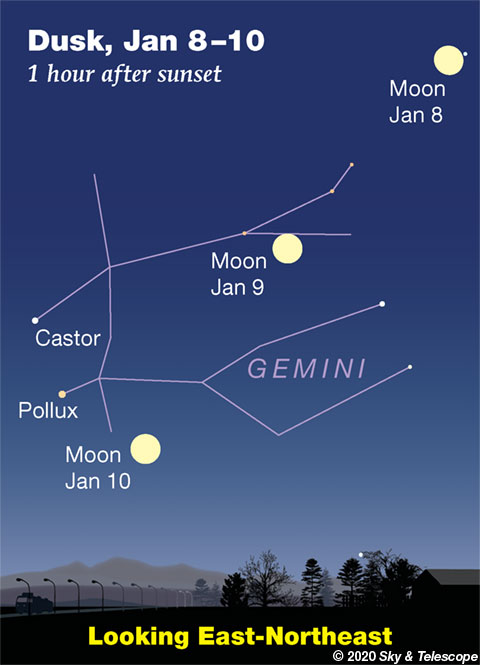
Wednesday, Jan. 8
• The dark limb of the nearly full Moon occults 3rd-magnitude Zeta Tauri for most of North America, but only in the east does the occultation happen during twilight or darkness. Map and timetables for the star's disappearance and reappearance.
Outside of occultation, Zeta can be seen less than 1° from the Moon in early evening for the East Coast; about 2° from the Moon for the West Coast.
• Meanwhile, Venus is passing 1° from 2.8-magnitude Delta Capricorni this evening. Venus, magnitude –4.0, is 500 times brighter.
Thursday, Jan. 9
• Zero-magnitude Capella high in the east after dinnertime, and equally bright Rigel in Orion's foot, have almost the same right ascension. This means they cross your sky’s meridian at almost exactly the same time: around 10 p.m. now, depending on how far east or west you live in your time zone. (Capella goes exactly through your zenith if you're at latitude 46°N: Portland, Oregon; Montreal; central France.) So whenever Capella passes highest, Rigel always marks true south over your landscape, and vice versa.
Friday, Jan. 10
• Full Moon (exact at 2:21 p.m. EST). This evening look for Pollux and Castor to the Moon's upper left, as shown one panel above. Procyon shines farther to the Moon's lower right.
• The Moon goes through a penumbral eclipse for observers in Europe, Africa, Asia, and Australia, as it skims through the pale outer fringe of Earth's shadow. This eclipse is pretty deep as penumbral ones go: the Moon misses the shadow's dark umbra by only about 10% of the Moon's diameter. Therefore the shading on the Moon's southern side will be pretty obvious around the event's mid-time, 19:10 January 10th UT (GMT). Full details. Live video stream (starts at 17:00 UT).
Saturday, Jan. 11
• Here it is the coldest very bottom of the year, but the Summer Star, Vega, is still barely hanging in there. Maybe. Look for it twinkling over the northwest horizon during and shortly after nightfall. The farther north you are the higher it will be. If you're north of latitude 51° (Calgary, central Ontario and Quebec, London, Berlin), Vega is actually circumpolar. But if you're too far south, it's already gone.
________________________
Want to become a better astronomer? Learn your way around the constellations. They're the key to locating everything fainter and deeper to hunt with binoculars or a telescope.
This is an outdoor nature hobby, cold or not! For an easy-to-use constellation guide covering the whole evening sky, use the big monthly map in the center of each issue of Sky & Telescope, the essential guide to astronomy.

Once you get a telescope, to put it to good use you'll need a detailed, large-scale sky atlas (set of charts). The basic standard is the Pocket Sky Atlas (in either the original or Jumbo Edition), which shows stars to magnitude 7.6.
Next up is the larger and deeper Sky Atlas 2000.0, plotting stars to magnitude 8.5; nearly three times as many. The next up, once you know your way around, are the even larger Interstellarum atlas (stars to magnitude 9.5) and Uranometria 2000.0 (stars to magnitude 9.75). And read how to use sky charts with a telescope.
You'll also want a good deep-sky guidebook, such as Sue French's Deep-Sky Wonders collection (which includes its own charts), Sky Atlas 2000.0 Companion by Strong and Sinnott, or the bigger Night Sky Observer's Guide by Kepple and Sanner.
Can a computerized telescope replace charts? Not for beginners, I don't think, and not on mounts and tripods that are less than top-quality mechanically (meaning heavy and expensive). And as Terence Dickinson and Alan Dyer say in their Backyard Astronomer's Guide, "A full appreciation of the universe cannot come without developing the skills to find things in the sky and understanding how the sky works. This knowledge comes only by spending time under the stars with star maps in hand."
This Week's Planet Roundup
Mercury is out of sight in conjunction with the Sun.
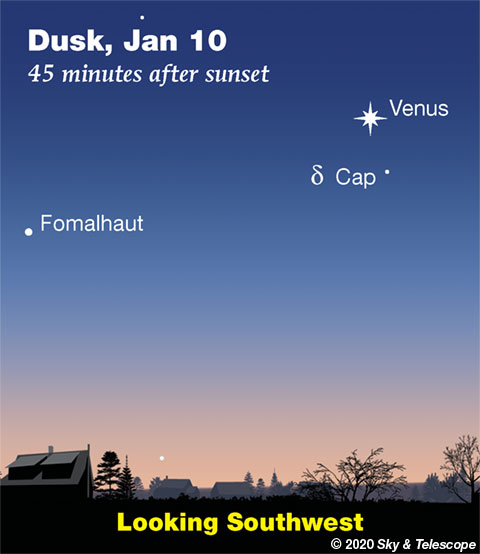
Venus (magnitude –4.0, in Capricornus) dominates the southwest during and after twilight, higher each week. It will shine as the grand "Evening Star" at dusk all winter and into the spring. In a telescope Venus still appears small (13 arcseconds) and gibbous, since it's still on the far side of the Sun from us.
Mars (magnitude +1.6, passing from Libra into Scorpius) glows in the southeast before and during early dawn, not very high. It too is still on the far side of the Sun from us and is a very tiny 4 arcseconds in diameter.
Down below it, watch for Mars-colored Antares twinkling as it rises into view. Antares is 10° below Mars on the morning of January 4th, and 7° below it by the 11th.
Jupiter is hidden deep in the glow of sunrise.
Saturn is lost in the sunset.
Uranus (magnitude 5.8, in southern Aries) and Neptune (magnitude 7.9, in eastern Aquarius) stand high in the south and lower in the southwest, respectively, right after dark. Use our finder charts for Uranus and Neptune.
All descriptions that relate to your horizon — including the words up, down, right, and left — are written for the world's mid-northern latitudes. Descriptions that also depend on longitude (mainly Moon positions) are for North America.
Eastern Standard Time (EST) is Universal Time (UT, UTC, GMT, or Z time) minus 5 hours.
![]() Audio sky tour. Out under the evening sky with your earbuds in place, listen to Kelly Beatty's monthly podcast tour of the heavens above. It's free.
Audio sky tour. Out under the evening sky with your earbuds in place, listen to Kelly Beatty's monthly podcast tour of the heavens above. It's free.
 5
5








Comments
mary beth
January 3, 2020 at 12:26 am
Happy New Year Rod....hope you’ve had a nice 12 days of Christmas!
You must be logged in to post a comment.
Rod
January 3, 2020 at 6:11 pm
Same to you mary beth and yes I did enjoy. The 12 days are not quite over yet - epiphany is coming and my stocking is full of lumps of coal 🙂 Family and grandson over (multiple times) and guests tonight too but clouds and light rain in my area now. No Quadrantids for me this year :)--Rod
You must be logged in to post a comment.
mary beth
January 4, 2020 at 12:47 pm
You better double check that coal, maybe Santa was nice and gave you some meteorites ! Happy ‘Little Christmas’ , as my Italian mom called it! Clear skies here all week ahead!
You must be logged in to post a comment.
James
January 5, 2020 at 8:12 am
Hi Alan, I commented last week about Jan 5th. You say "purely by coincidence" that the latest sunrise is on the same day as perihelion. In the strictest sense, I think that's true, but the earth being near perihelion is one of the reasons the sunrise times vary, so it's not completely coincidental.
Enjoyed the column a lot!
You must be logged in to post a comment.
misha17
January 9, 2020 at 5:46 pm
I found a site in India that will be streaming the Jan 10th penumbral lunar eclipse:
"Where to watch Lunar Eclipse/ Chandra Grahan online?
You can enjoy Lunar Eclipse or Chandra Grahan on YouTube channel CosmoSapiens. You can watch the celestial event LIVE at 10:37 pm Indian Time on January 10. The maximum eclipse will be at 12:40 am on January 11. The penumbral eclipse will end at 2:42 am."
YouTube link:
https://www.youtube.com/watch?v=xo2Qzo7Tauc&feature=emb_title
"Penumbral eclipse begins: 17:07:45 UTC
Maximum eclipse: 19:09:59 UTC
Penumbral eclipse ends: 21:12:19 UTC"
Based on the UTC/India times for Maximum Eclipse, India time is 5 1/2 hrs ahead of UTC.
You must be logged in to post a comment.
You must be logged in to post a comment.